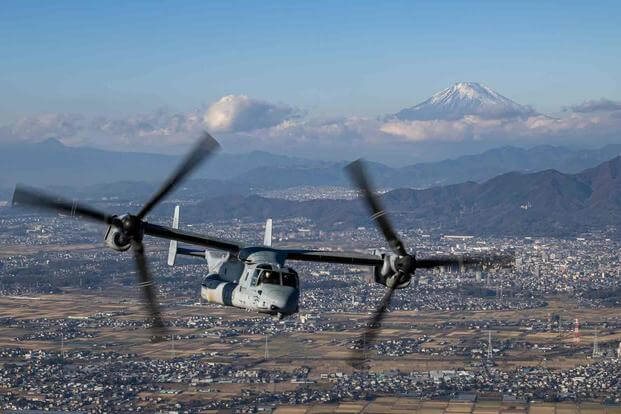A senior defense official has confirmed that Defense Secretary Lloyd Austin has been briefed on the plans to return the V-22 Osprey tilt-rotor aircraft to flight after a nearly three-month grounding, but the exact timing of that return remained unclear Monday.
Despite the briefing, which is seen as a step closer to lifting the grounding following a deadly crash of an Air Force Special Operations Command Osprey on Nov. 29 that killed eight airmen, none of the services was answering the question of when it expects to fly the aircraft again.
The Associated Press reported Friday that the flight ban would be lifted this week. However, officials for the Navy and Air Force chose not to answer questions Military.com posed to them about that timing. The Marine Corps simply said it had no updates.
Read Next: Veterans' Gun Rights Amendment Included in Compromise Must-Pass VA Spending Bill
The move to return the aircraft to flight would raise many questions since the Osprey has had a spate of deadly crashes -- in addition to the Air Force's November crash off the coast of Japan, there was a deadly Marine Corps Osprey crash in Australia last summer for which the investigations have not been completed.
There is also an ongoing problem with the aircraft's clutch systems that turned deadly in June 2022. The military has claimed the issue is under control, despite it not having a full understanding of the cause.
Sabrina Singh, a spokeswoman for the Pentagon, said that she wasn't "going to get ahead of any notifications" when asked whether U.S. officials would notify Japan before resuming Osprey flights.
Japanese government officials expressed concerns over Osprey operations late last year shortly after the Air Force crash. Two months before the Nov. 29 Osprey crash, two Marine Ospreys flying over Japan had to divert within hours of each other due to "cockpit caution indications" in the aircraft while flying near where the Air Force Osprey crashed.
Marcia Hart, a spokeswoman for the Navy's Air Systems Command, the office that issued the grounding bulletin and the authority on when it will be lifted, confirmed only that "conversations are ongoing between V-22 stakeholders about when a return to flight of the V-22 will occur."
Hart did say that "currently, we have no evidence that suggests there is a correlation" between the hard clutch engagement issue that has been a problem for years and circumstances of the November crash of the Air Force Osprey.
Meanwhile, the Air Force, when asked similar questions by Military.com, chose not to answer any of them directly and instead said that Air Force Special Operations Command "remains in close coordination" with Naval Air Systems Command and "any change in the status of the V-22 fleet's operational status will come in the form of an updated flight bulletin" from that command.
Defense officials have stressed on several occasions that once Naval Air Systems Command lifts the grounding bulletin, it would still be up to the individual services to decide how and when Ospreys begin flying again.
The Marine Corps, which operates the vast majority of the military's V-22 fleet, has signaled that it needs to get the aircraft back in the air. A top Marine general told a conference panel in February that the Corps has seen "dramatic impacts" from the flying halt and on operations for three Marine expeditionary units, or MEUs -- including the 26th MEU currently on deployment with the Bataan Amphibious Ready Group in the Mediterranean.
Meanwhile, the Air Force has been more reserved.
Last month, Air Force officials publicly confirmed said that a parts failure occurred during the November Osprey crash in Japan, but said the root cause of the crash was still unknown.
The head of Air Force Special Operations Command, Lt. Gen. Tony Bauernfeind, told reporters last month that, while there is a "strong desire" to return to flying the Osprey, "we want to be able to return to fly with as much knowledge as we possibly can so that we can ensure that we are safely taking care of our crews as it goes forward."
Finally, the Navy, which was planning on using the aircraft to replace its aging fleet of C-2 Greyhounds that keep carriers supplied at sea, was forced to surge the last remaining squadron of 15 Greyhounds "to meet the Carrier Onboard Delivery mission for deployed aircraft carriers in U.S. 5th and 7th Fleets," Cmdr. Beth Teach, a spokeswoman for the Navy's aviation boss, told reporters last month.
-- Drew Lawrence contributed to this report.
Related: Air Force Confirms Parts Failure Occurred in Deadly Japan Osprey Crash that Left 8 Airmen Dead















